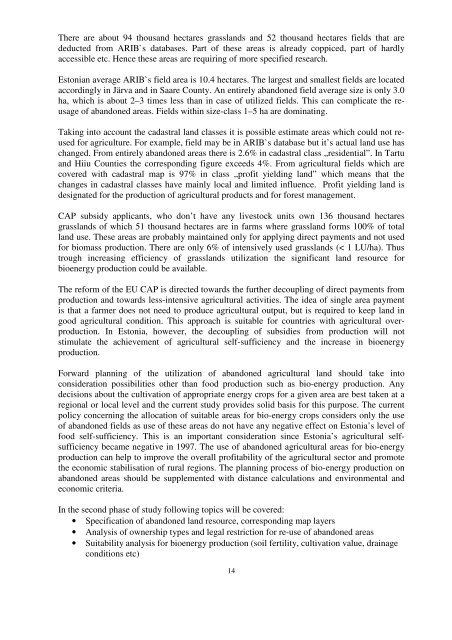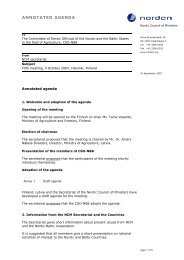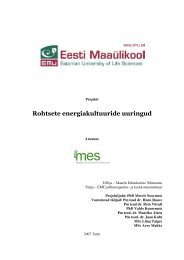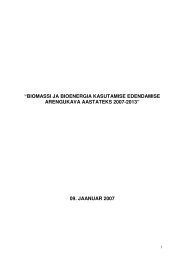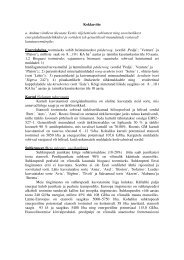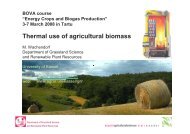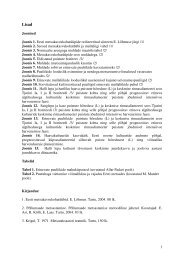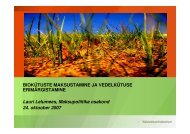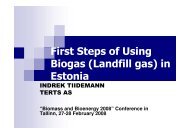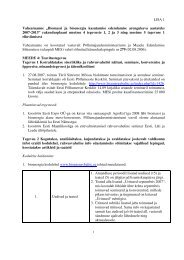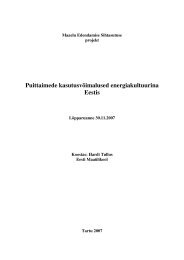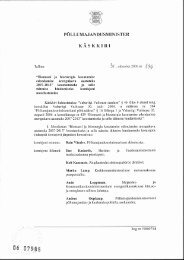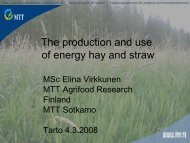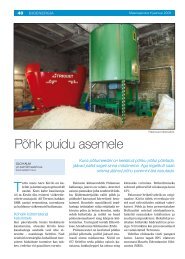Põllumajandusministeeriumi ja Maaelu ... - bioenergybaltic
Põllumajandusministeeriumi ja Maaelu ... - bioenergybaltic
Põllumajandusministeeriumi ja Maaelu ... - bioenergybaltic
Create successful ePaper yourself
Turn your PDF publications into a flip-book with our unique Google optimized e-Paper software.
There are about 94 thousand hectares grasslands and 52 thousand hectares fields that are<br />
deducted from ARIB`s databases. Part of these areas is already coppiced, part of hardly<br />
accessible etc. Hence these areas are requiring of more specified research.<br />
Estonian average ARIB`s field area is 10.4 hectares. The largest and smallest fields are located<br />
accordingly in Järva and in Saare County. An entirely abandoned field average size is only 3.0<br />
ha, which is about 2–3 times less than in case of utilized fields. This can complicate the reusage<br />
of abandoned areas. Fields within size-class 1–5 ha are dominating.<br />
Taking into account the cadastral land classes it is possible estimate areas which could not reused<br />
for agriculture. For example, field may be in ARIB`s database but it’s actual land use has<br />
changed. From entirely abandoned areas there is 2.6% in cadastral class „residential”. In Tartu<br />
and Hiiu Counties the corresponding figure exceeds 4%. From agricultural fields which are<br />
covered with cadastral map is 97% in class „profit yielding land” which means that the<br />
changes in cadastral classes have mainly local and limited influence. Profit yielding land is<br />
designated for the production of agricultural products and for forest management.<br />
CAP subsidy applicants, who don’t have any livestock units own 136 thousand hectares<br />
grasslands of which 51 thousand hectares are in farms where grassland forms 100% of total<br />
land use. These areas are probably maintained only for applying direct payments and not used<br />
for biomass production. There are only 6% of intensively used grasslands (< 1 LU/ha). Thus<br />
trough increasing efficiency of grasslands utilization the significant land resource for<br />
bioenergy production could be available.<br />
The reform of the EU CAP is directed towards the further decoupling of direct payments from<br />
production and towards less-intensive agricultural activities. The idea of single area payment<br />
is that a farmer does not need to produce agricultural output, but is required to keep land in<br />
good agricultural condition. This approach is suitable for countries with agricultural overproduction.<br />
In Estonia, however, the decoupling of subsidies from production will not<br />
stimulate the achievement of agricultural self-sufficiency and the increase in bioenergy<br />
production.<br />
Forward planning of the utilization of abandoned agricultural land should take into<br />
consideration possibilities other than food production such as bio-energy production. Any<br />
decisions about the cultivation of appropriate energy crops for a given area are best taken at a<br />
regional or local level and the current study provides solid basis for this purpose. The current<br />
policy concerning the allocation of suitable areas for bio-energy crops considers only the use<br />
of abandoned fields as use of these areas do not have any negative effect on Estonia’s level of<br />
food self-sufficiency. This is an important consideration since Estonia’s agricultural selfsufficiency<br />
became negative in 1997. The use of abandoned agricultural areas for bio-energy<br />
production can help to improve the overall profitability of the agricultural sector and promote<br />
the economic stabilisation of rural regions. The planning process of bio-energy production on<br />
abandoned areas should be supplemented with distance calculations and environmental and<br />
economic criteria.<br />
In the second phase of study following topics will be covered:<br />
• Specification of abandoned land resource, corresponding map layers<br />
• Analysis of ownership types and legal restriction for re-use of abandoned areas<br />
• Suitability analysis for bioenergy production (soil fertility, cultivation value, drainage<br />
conditions etc)<br />
14


